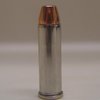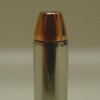OK, I have replaced the "crimp die" with a 9mm re-sizing die with the de-capper removed in my progressive.
Thankfully it has enough 7/8-14 threads to adjust it to just remove the case bell/flare, or as I like to call "de-flaring" not crimping.
It seems to be working as all ammo plunks in my tightest 9mm barrel, so far.
I won't bore you with pics as you can't see much/any difference from a round loaded with the usual crimp die or a FCD.
It this a common practice that just never gets mentioned?
Does anyone else do this or have tried it?
Do you see any potential problems?
Thanks for reading this post and posting here,

Thankfully it has enough 7/8-14 threads to adjust it to just remove the case bell/flare, or as I like to call "de-flaring" not crimping.
It seems to be working as all ammo plunks in my tightest 9mm barrel, so far.
I won't bore you with pics as you can't see much/any difference from a round loaded with the usual crimp die or a FCD.
It this a common practice that just never gets mentioned?
Does anyone else do this or have tried it?
Do you see any potential problems?
Thanks for reading this post and posting here,




